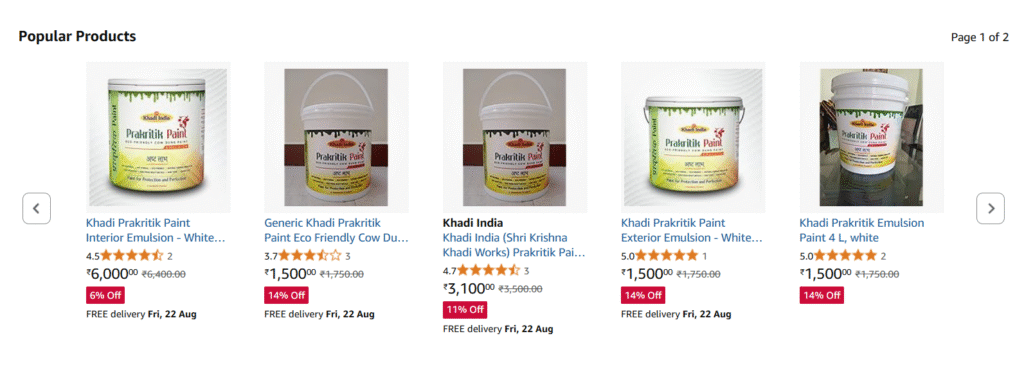An Overview of Natural Paints
As awareness about environmental sustainability and personal health grows, so does the demand for eco-friendly products. One such product gaining significant traction is natural paint. Unlike conventional paints, which are often laden with volatile organic compounds (VOCs) and synthetic chemicals, natural paints are formulated from renewable, plant- and mineral-based materials. We are exploring Natural Paints manufacturing process, key raw materials, numerous benefits, and providing a practical guide on how to purchase them.
The Manufacturing Unit: A Shift Towards Green Production
A natural paint manufacturing unit is fundamentally different from its conventional counterpart. While a standard paint factory might involve large, complex chemical reactors and extensive ventilation systems to handle toxic fumes, a natural paint facility is designed for a cleaner, more sustainable process.
Raw Material for Natural Paint manufacturing:
Raw Material Storage: Raw materials are stored in separate, climate-controlled sections to maintain their quality. Dry materials like mineral pigments and clay powders are kept in silos or large sacks, while liquid binders and oils are stored in tanks.
Mixing and Dispersion: This is the core of the manufacturing process. Unlike conventional paints that require high-speed dissolvers to break down synthetic resins, natural paints are mixed in large vats using low-energy mixers. Pigments and fillers are dispersed into the liquid binders to create a homogeneous slurry. This process often takes longer but consumes less energy.
Milling and Grinding: Some raw materials, especially mineral pigments and fillers, may need to be finely ground to achieve the desired particle size. This is done using ball mills or bead mills, which are designed to create a smooth, consistent texture in the final product.
Filling and Packaging: Once the paint has the correct consistency and color, it is transferred to a filling machine. Natural paints are typically packaged in recyclable metal cans or glass jars, further minimizing the environmental footprint.
The manufacturing process is also characterized by a closed-loop system, where waste is minimized and by-products are often recycled. For example, water used for cleaning equipment can be filtered and reused in subsequent batches. The focus is on a low-energy, low-waste, and non-toxic production environment.
Key Raw Materials for Natural Paint: Nature’s Palette
The beauty of natural paint lies in its simple, earth-derived ingredients. The raw materials can be broadly categorized into four groups:
Binders: These are the glues that hold the paint together and make it adhere to a surface. Common natural binders include:
Plant-based oils: Linseed oil, tung oil, and sunflower oil are excellent binders. They are pressed from seeds and react with oxygen to form a durable, protective film.
Resins: Plant resins like rosin (from pine trees) or casein (a protein from milk) are used to create a hard, durable finish.
Natural Gums: Gum arabic and other natural gums can be used as binders, particularly in watercolor and distemper-style paints.
Fillers: These materials add bulk, texture, and opacity to the paint. They also help to control the paint’s consistency and reduce the cost.
Clay and chalk: These are abundant and provide a smooth, matte finish.
Marble powder and talc: Used to create a hard, durable surface and add body to the paint. Pigments: The color in natural paints comes from mineral and earth pigments.
Earth pigments: Ochers (yellow, brown), umbers (dark brown), and siennas (red-brown) are derived from iron oxides naturally found in the soil.
Mineral pigments: Ultramarine (blue, from a mineral called lapis lazuli), titanium dioxide (white), and green earth are examples of mineral-based pigments.
Plant-based dyes: While less common for architectural paints, plant extracts can be used to create certain colors. For example, indigo can produce a deep blue.
Solvents and Additives: These are used to adjust the paint’s flow, drying time, and other properties.
Water: The most common solvent for natural paints, making them easy to clean up and non-toxic.
Essential oils: Citrus and pine essential oils are sometimes used as a natural solvent and to provide a pleasant scent.

The Benefits of Natural Paint:
Choosing natural paint offers a host of benefits that extend far beyond simply having a beautiful wall.
Healthier Indoor Air Quality: The most significant benefit is the absence of VOCs and other harmful chemicals. Conventional paints release these compounds for months or even years, contributing to “sick building syndrome,” headaches, and respiratory issues.
Natural paints, by contrast, emit no toxic fumes, ensuring a healthier living or working environment. Eco-Friendly and Sustainable: Made from renewable resources, natural paints have a minimal environmental footprint.
The production process is less energy-intensive, and the ingredients are biodegradable. This reduces landfill waste and the depletion of non-renewable resources. Breathable and Moisture-Regulating: Natural paints, especially those made with clay or lime, are microporous. This means they allow walls to “breathe,” regulating humidity and preventing moisture buildup. This can help to prevent mold and mildew growth, making them ideal for bathrooms and older buildings.
Durability and Long-Term Performance: Contrary to popular belief, natural paints are highly durable. They age gracefully, developing a beautiful patina over time. They are resistant to cracking and flaking, and their mineral-based pigments offer excellent color fastness.
Aesthetics and Texture: Natural paints offer a unique aesthetic that is difficult to replicate with synthetic paints. The subtle variations and depth of color from earth pigments create a warm, organic feel. Some natural paints, like those with clay or lime, offer a unique, textured finish.
How to Purchase Natural Paint: A Practical Guide
Purchasing natural paint requires a bit of research, as the market is still smaller than for conventional paints. Here’s a name you can trust, “Khadi” The Prakritik Paint Manufacturers Association help you for decision-making. You can find a Reputable Supplier: Natural paints are often sold by specialized retailers or directly from the manufacturer’s website.
These suppliers can offer products on amazon on the best product for your project, application techniques, and maintenance.
Natural paint represents a significant step forward in the quest for a more sustainable and healthier living environment.

